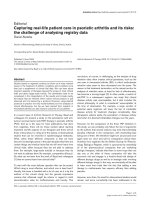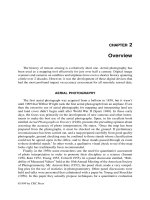International bussiness the challenge of global competition 11e chapter 01
Bạn đang xem bản rút gọn của tài liệu. Xem và tải ngay bản đầy đủ của tài liệu tại đây (451.56 KB, 23 trang )
chapter one
The Rapid Change of
International Business
McGraw-Hill/Irwin
International Business, 11/e
Copyright © 2008 The McGraw-Hill Companies, Inc. All rights reserved.
Learning Objectives
• Appreciate the dramatic internationalization of markets
• Understand the various names given to firms that have
operations in more than one country
• Understand the five kinds of drivers, all based on change,
that are leading international firms to globalize
• Comprehend why international business differs from
domestic business
• Describe the three environments—domestic, foreign, and
international--in which an international firm operates
1-3
International Business Terminology
• International business
• Foreign business
• Multidomestic company (MDC)
• Global company (GC)
• International company (IC)
1-4
International Business Terminology,
cont’d.
• International Business
– A business whose activities are carried out across
national boarders
• Foreign Business
– The operations of a company outside its home or
domestic market
• Multidomestic Company
– An organization with multicountry affiliates
• Each formulates its own business strategy on perceived
market differences
1-5
International Business Terminology,
cont’d.
• Global Company
– an organization that attempts to standardize and
integrate operations worldwide in most of all
functional areas
• International Company
– A global or multidomestic company
1-6
History of International Business
• Early traders
– Well before the time of Christ, Phoenician and
Greek merchants
– China stimulated the emergence of an
internationally integrated trading system
• “all roads lead to China”
• 17th Century mercantilism/colonialism
– British East India Company
– Dutch East India Company
– Portugal and France
1-7
Globalization
• Globalization
– Coined by Theodore Levitt
• “as if the entire world (or major regions of it) were a single
entity; [such an organization] sells the same things in the
same way everywhere”
• Economic Globalization
– International integration of goods, technology,
information, labor, and capital
– Process of making this integration happen
1-8
Table 1.1 Globalization Rankings: The KOF Index
of Globalization and the A.T Kearney/Foreign
Policy Globalization Index
1-9
Globalization Forces
• Political forces
– Reduction of barriers to trade and foreign
investment by governments
– Privatization of former communist nations
• Technological forces
– Advances in computers and communications
technology
– Internet and network computing
1-10
Globalization Forces, cont’d.
• Market forces
– Globalizing companies become global customers
• Cost forces
– Goal for economies of scale to reduce unit costs
• Competitive forces
– Increase in intensity due to explosive growth in
international business
1-11
Explosive Growth
• Foreign Direct Investment and Exporting
– FDI - Direct investment in equipment, structures,
and organizations in a foreign country
• level sufficient to obtain significant management control
(Table 1.2)
– Exporting – transportation of any domestic
good/service to a destination outside a country or
region
1-12
Table 1.2 FDI Indicators and Multinational
Company Statistics (billions of dollars and
percentages)
1-13
Explosive Growth
• Number of International Companies
– UNCTAD - United Nations agency in charge of all
matters relating to FDI and international
corporations.
• 1995 – 45,000 parent companies with 280,000 foreign
affiliates ($7 trillion in sales)
• 2004 – 70,000 parent companies with 690,000 foreign
affiliates ($19 trillion in sales)
1-14
Table 1.3 Ranking of International Companies
and nations according to GNI (Atlas Method) or
Total Sales
Note: Belgium (B), China (PRC), France (F), Germany (G), Italy (It), Netherlands (N), Switzerland (S), United Kingdom (U.K.), and United
States (U.S.). Source: World Development Indicators database, (July 4, 2006); and Fortune
2005 Global 500, (July 4, 2006).
1-15
Globalization Debate And You
• World Trade Organization (1999, Seattle)
– Extensive public protests about globalization and the
liberalization of international trade
• Debate –
– Waged by diametrically opposed groups with extremely
different views on consequences of globalization
– Dramatic reductions in worldwide poverty are contrasted with
anecdotal stories of people losing their livelihoods under the
growing power of multinationals
1-16
Environments of International
Business
• Environment
– All the forces influencing the life and development
of the firm
• Forces
– External Forces (Uncontrollable) – Forces over
which management has no direct control
– Internal Forces (Controllable) – Forces that
management can use to adapt to external forces
1-17
External Forces
• Competitive
– Kind, number, location
• Distributive
– For distributing goods and services
• Economic
– GNP, unit labor cost, personal consumption
expenditure
• Socioeconomic
– Characteristics of human population
• Financial
– Interest rates, inflation rates, taxation
1-18
External Forces, cont’d.
• Legal
– Laws governing how international firms must operate
• Physical
– Topography, climate, and natural resources
• Political
– Forms of government, and international organizations
• Sociocultural
– Attitudes, beliefs, and opinions
• Labor
– Skills, attitudes of labor
• Technological
– Equipment and skills that affect how resources are converted to
products
1-19
Internal Environmental Forces
• Factors of Production
– Capital, raw materials, and people
• Activities of the organization
– Personnel, finance, production, and marketing
1-20
Why Is International Business
Different?
• Domestic Environment
– All the uncontrollable forces in the home country
that surround and influence the firm’s life and
development
• Foreign Environment
– All the uncontrollable forces originating outside the
home country that surround and influence the firm
• different values
• difficult to assess
• interrelated
1-21
Why Is International Business
Different? cont’d.
• International Environment
– Interaction between domestic and foreign
environmental forces or between sets of foreign
environmental forces
– Increased complexity for decision-making
• Decision making more complex
1-22
International Business Model
1-23









